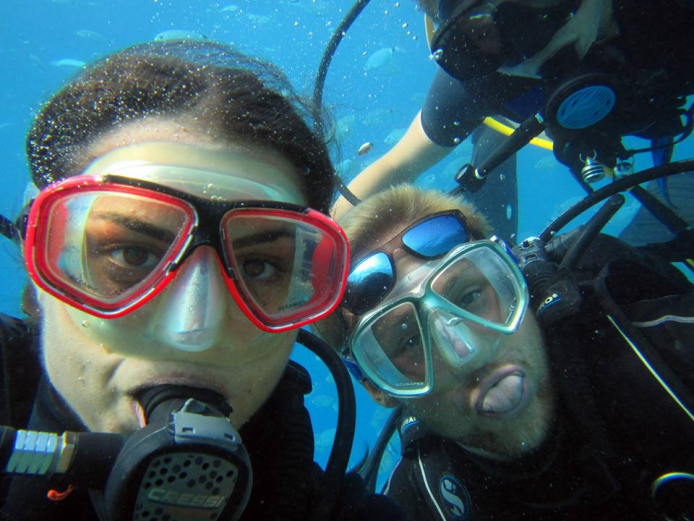One of sport diving's most sacred rules has been challenged and found lacking: the prohibition against reverse dive profiles (following a shallow dive with a deeper one) that resulted in a phrase memorized by millions of divers: "Always do your deepest dive first."

Well, it turns out, if you're using a divecomputer for multilevel diving, you can do your dives in any order you wish. Of course, use your dive computerintelligently and stay within the no-decompression limits. Yes, this reverse profile is fine--50 feet for 45 minutes followed one hour later by a dive to 90 feet for 20 minutes. The U.S. Navy tables would require an 18-minute decompression stop at 10 feet, and the PADI RDP does not allow for the second dive, as it is off the tables. All modern dive computers allow for these reverse profile dives.That's the conclusion of the "Reverse Dive Profiles Workshop" conducted at the Smithsonian Institution in Washington, D.C. Under the guidance of the Smithsonian's Michael Lang, the American Academy of Underwater Sciences, DAN, DEMA and Dive Training magazine, 49 leaders from a cross section of diving gathered to listen to 29 scholarly papers delivered over a two-day period, followed by eight discussion sessions to hammer out consensus findings.
The conclusions of the workshop are historic. Not only do they provide greater freedom for experienced computer divers to plan and execute multilevel dives; but the broader impact will likely be that the entire dive industry will take a more open-minded look at other rules of diving, skills and procedures, and then ask "Why?"
This spirit of re-evaluation was underscored in the workshop's opening address when John Lewis, Ph.D., the leading programmer of dive computers, presented a paper on "The Evolution of Repetitive Diving: From Haldane (1908) to Hardy (1999)." Dr. Lewis was referring to physiologist J.S. Haldane's original work on decompression tables at the beginning of the century and Rodale's Scuba Lab Director Jon Hardy's work at the end of it. Hardy's Scuba Lab test results on reverse profiles, reported in the July 1999 issue of Rodale's Scuba Diving (RSD), challenged the need to dive deep first and ignited such controversy that a follow-up article defending the tests appeared in RSD's October 1999 issue.
But this was not the first challenge to the absolute rule to always dive deep then shallow. In RSD's July 1994 issue, Hardy, John Brumm and Val Hodges first challenged the concept based on Scuba Lab's early dive computer tests. And, in late 1988, at the AAUS Dive Computer Workshop, Hardy presented a paper based on the field experience of working divers who dived in a so-called "out of order" manner with no known ill effects.
The cumulative findings make it clear: Recreational divers are no longer limited to the severe confines of printed tables, but can use modern dive computers to expand their dive opportunities, to dive more efficiently, more comfortably, more safely and more enjoyably.
Key Findings of the "Reverse Dive Profiles Workshop"
-
Historically neither the U.S. Navy nor the commercial sector have prohibited reverse dive profiles.
-
Reverse dive profiles are being performed in recreational, scientific, commercial and military diving.
-
The prohibition of reverse dive profiles by recreational training organizations cannot be traced to any specific diving experience that indicates an increased risk of DCS.
-
No convincing evidence was presented in the workshop that reverse dive profiles within the no-decompression limits lead to a measurable increase in the risk of DCS.
-
The attendees found no reason for diving communities to prohibit reverse dive profiles for no-decompression dives less than 40 meters (130 feet) and depth differentials less than 12 meters (40 feet).
Proceedings of "Reverse Dive Profiles Workshop"
The complete text can be ordered from:
American Academy of Underwater Sciences (AAUS), 430 Nahant Rd., Nahant, MA 01980-1696; tel: (781) 581-7370, ext. 334; fax: (781) 581-6076; e-mail: [email protected]; web: www.aaus.org.
Undersea and Hyperbaric Medical Society (UHMS), 10531 Metropolitan Ave., Kensington, MD 20895; tel: (301) 942-2980; fax: (301) 942-7804; e-mail: [email protected]; web: www.uhms.org.
http://www.scubadiving.com/training/basic-skills/deepest-dive-first-not-anymore?OtuDFXdrpE1DcgI1.01










